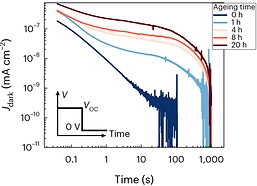
Photon Energy Conversion Lab
Research Group at CUHK
Department of Electronic Engineering

Minimizing Recombination at the Perovskite/C60 Interface through a Volatile Highly Dense Molecular Interlayer. ACS Energy Lett. 2025, 10, 6, 2942–2951
Advancing inverted perovskite solar cells requires effective strategies to mitigate nonradiative recombination at the perovskite/C60 interface. Here, we report a volatile material that forms a thin, dense interlayer that essentially eliminates the C60-induced nonradiative interfacial recombination loss despite not directly passivating the perovskite surface. Ultraviolet photoelectron spectroscopy highlights that the molecule forms a positive dipole layer on the surface that aligns the perovskite and C60 energy levels for electron conduction. Furthermore, the molecule’s volatile nature allows the use of a high-concentration solution that enables a high surface coverage (likely >99%) without increasing the thickness. The combination of these two effects yields an effective approach to suppressing interface recombination. The resulting triple cation perovskite solar cells achieved a power conversion efficiency of >25% and the devices maintain >90% of their initial efficiency after 1200 h of operation. Furthermore, the molecule is broadly applicable to various perovskite compositions and bandgaps.




Thiesbrummel, J. et al. Ion-induced field screening as a dominant factor in perovskite solar cell operational stability. Nat. Energy 9, 664–676 (2024).
The presence of mobile ions in metal halide perovskites has been shownto adversely affect the intrinsic stability of perovskite solar cells (PSCs).However, the actual contribution of mobile ions to the total degradationloss compared with other factors such as trap-assisted recombinationremains poorly understood. Here we reveal that mobile ion-induced internalfield screening is the dominant factor in the degradation of PSCs underoperational conditions. The increased field screening leads to a decrease inthe steady-state efficiency, often owing to a large reduction in the currentdensity. Instead, the efficiency at high scan speeds (>1,000 V s−1), where theions are immobilized, is much less affected. We also show that the bulk andinterface quality do not degrade upon ageing, yet the open-circuit voltagedecreases owing to an increase in the mobile ion density. This work revealsthe importance of ionic losses for intrinsic PSC degradation before chemicalor extrinsic mechanical effects manifest.






Reinforced Perovskite-Substrate Interfaces via Multi-Sited and Dual-Sided Anchoring. Adv. Mater. 2025, 37, 2506048.
Interfacial reliability is critical for the long-term stability of perovskite solar cells (PSCs), yet the perovskite-substrate interface represents the most vulnerable part in high-efficiency devices. Here, this interface, by incorporating a dual-sided anchoring polymeric hole-transporting interlayer is reinforced with abundant coordinating pyridyl units as side chains, which induces strong adhesion between the perovskite and substrate by forming multidimensional interactions with adjacent layers. This simultaneously enhances the mechanical strength through effective distribution and dissipation of mechanical stress and the electronic quality of the perovskite-substrate interface through defect passivation. The resulting PSCs exhibit a high power conversion efficiency (PCE) of 26.8% (certified at 26.6%). With a more robust perovskite composition, devices maintain 98% of their initial PCE of ≈26% after maximum-power-point tracking at 85 °C for 1500 h. These devices exhibit excellent fatigue resistance under thermal cycling (-40 to 85 °C), retaining 93% efficiency after undergoing 900 cycles.


